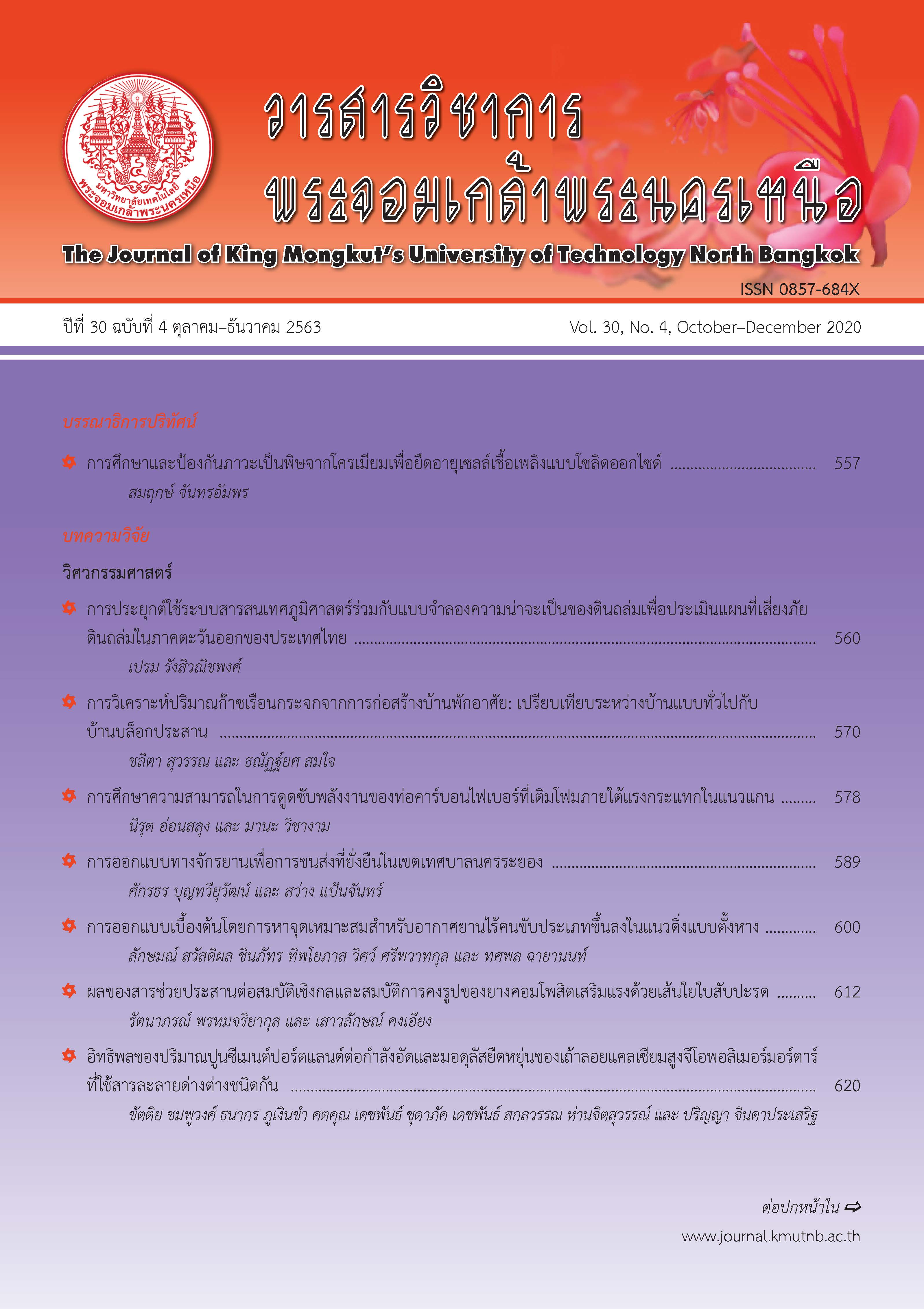การประยุกต์ใช้ระบบสารสนเทศภูมิศาสตร์ร่วมกับแบบจำลองความน่าจะเป็นของดินถล่มเพื่อประเมินแผนที่เสี่ยงภัยดินถล่มในภาคตะวันออกของประเทศไทย
Main Article Content
บทคัดย่อ
การศึกษาพื้นที่เสี่ยงภัยต่อการเกิดดินโคลนถล่มในพื้นที่ภาคตะวันออกของประเทศไทย งานวิจัยนี้ได้ประยุกต์ใช้ระบบสารสนเทศภูมิศาสตร์เพื่อประเมินแผนที่เสี่ยงภัยดินถล่มร่วมกับแบบจำลองความน่าจะเป็นของดินถล่ม (Landslide Probability Model) โดยใช้ข้อมูลฝนสูงสุดรายวัน จากสถานีตรวจวัดจำนวน 9 สถานี ซึ่งจะนำข้อมูลฝนสูงสุดรายวันมาวิเคราะห์หารอบปีการเกิดซ้ำตั้งแต่ 5, 10, 50 และ 100 ปี โดยจากงานวิจัยนี้พบว่า พื้นที่เสี่ยงภัยดินถล่มของภาคตะวันออกของประเทศไทย ส่วนมากจะเกิดขึ้นบริเวณจังหวัดจันทบุรีและตราด ตามแนวเทือกเขาบรรทัดและแนวทิวเขาสอยดาว และในการศึกษานี้ยังพบว่า พื้นที่เสี่ยงภัยดินถล่มในบริเวณภาคตะวันออกจะเพิ่มมากขึ้น ตามการเพิ่มขึ้นของปริมาณฝนที่มีรอบปีการเกิดซ้ำที่สูงขึ้น และพื้นที่ที่มีโอกาสเกิดดินถล่มมากกว่า 80% จะมีการขยายตัวเพิ่มมากขึ้นจนครอบคลุมร้อยละ 25 ของพื้นที่ทั้งหมดในภาคตะวันออก สำหรับรอบปีการเกิดซ้ำ 100 ปี นอกจากนี้ผลจากการประเมินความเสียหายจากภัยดินถล่มจะมีผลกระทบต่อเศรษฐกิจตั้งแต่ 0.4 ล้านบาทต่อตารางกิโลเมตร ในกรณีของปริมาณฝนที่มีรอบปีการเกิดซ้ำ 5 ปี และมีผลกระทบเพิ่มมากขึ้นเฉลี่ยจนถึง 1.8 ล้านบาทต่อตารางกิโลเมตร ในกรณีของรอบปีการเกิดซ้ำ 100 ปี
Article Details
บทความที่ลงตีพิมพ์เป็นข้อคิดเห็นของผู้เขียนเท่านั้น
ผู้เขียนจะต้องเป็นผู้รับผิดชอบต่อผลทางกฎหมายใดๆ ที่อาจเกิดขึ้นจากบทความนั้น
เอกสารอ้างอิง
[2] K. E. Trenberth, “The impact of climate change and variability on heavy precipitation, floods, and droughts,” Encyclopedia of Hydrological Sciences, pp. 1–11, 2008.
[3] D. Komori, P. Rangsiwanichpong, N. Inoue, K. Ono, S. Watanabe, and S. Kazama, “Distributed probability of slope failure in Thailand under climate change,” Climate Risk Management, vol. 20, no. 2018, pp. 126–137, 2018.
[4] L. Ciabatta, S. Camici, L. Brocca, F. Ponziani, M. Stelluti, N. Berni, and T. Moramarco, “Assessing the impact of climate-change scenarios on landslide occurrence in Umbria region, Italy,” Journal of Hydrology, vol. 541, pp. 285–295, 2016.
[5] J. D. Robinson, F. Vahedifard, and A. AghaKouchak, “Rainfall-triggered slope instabilities under a changing climate: Comparative study using historical and projected precipitation extremes,” Canadian Geotechnical Journal, vol. 54, no. 1 pp. 117–127, 2017.
[6] W. Inruang and T. Chaipimonplin, “The prediction of landslides risk areas in Uttaradit province by applying geo-informatics technology with an artificial neural network,” Journal of Social Sciences Srinakharinwirot University, vol. 18, pp. 191–207, 2015 (in Thai).
[7] S. Soralump, “Rainfall-triggered landslide: From research to mitigation practice in Thailand,” Geotechnical Engineering Journal of the SEAGS & AGSSEA, vol. 41, no. 1, pp. 1–6, 2010 (in Thai).
[8] S. Pomthong and D. Asavasuthirakul, ”Analysis of landslide risk area in Phetchabun province,” Journal of Geoinformation Technology of Burapha University, vol. 2, no.3, pp. 41–52, 2017 (in Thai).
[9] B. Boongthong, “An analysis of areas susceptible to landslide hazard in Chanthaburi province,” M.S. thesis, Department of Geography, Faculty of Education, Ramkhamhaeng University, 2001 (in Thai).
[10] K. Arora and V. P. Singh, “A comparative evaluation of the estimators of the log pearson type (LP) 3 distribution,” Journal of Hydrology, vol. 105, no. 1–2, pp. 19–37, 1989.
[11] S. Kawagoe, S. Kazama, and P. R. Sarukkalige, “Probabilistic modelling of rainfall induced landslide hazard assessment,” Hydrology and Earth System Sciences, vol. 14, pp. 1047–1061, 2010.
[12] P. Rangsiwanichpong, S. Kazama, and D. Komori, “Assessment expected annual damage cost of landslides in Thailand,” in Proceeding Japan Society of Civil Engineering Conference; Tohoku Branch, 2016, pp. 1–2.

